Charles E W Bean, Diaries, AWM38 3DRL 606/246/1 - 1916 - 1929 - Part 5
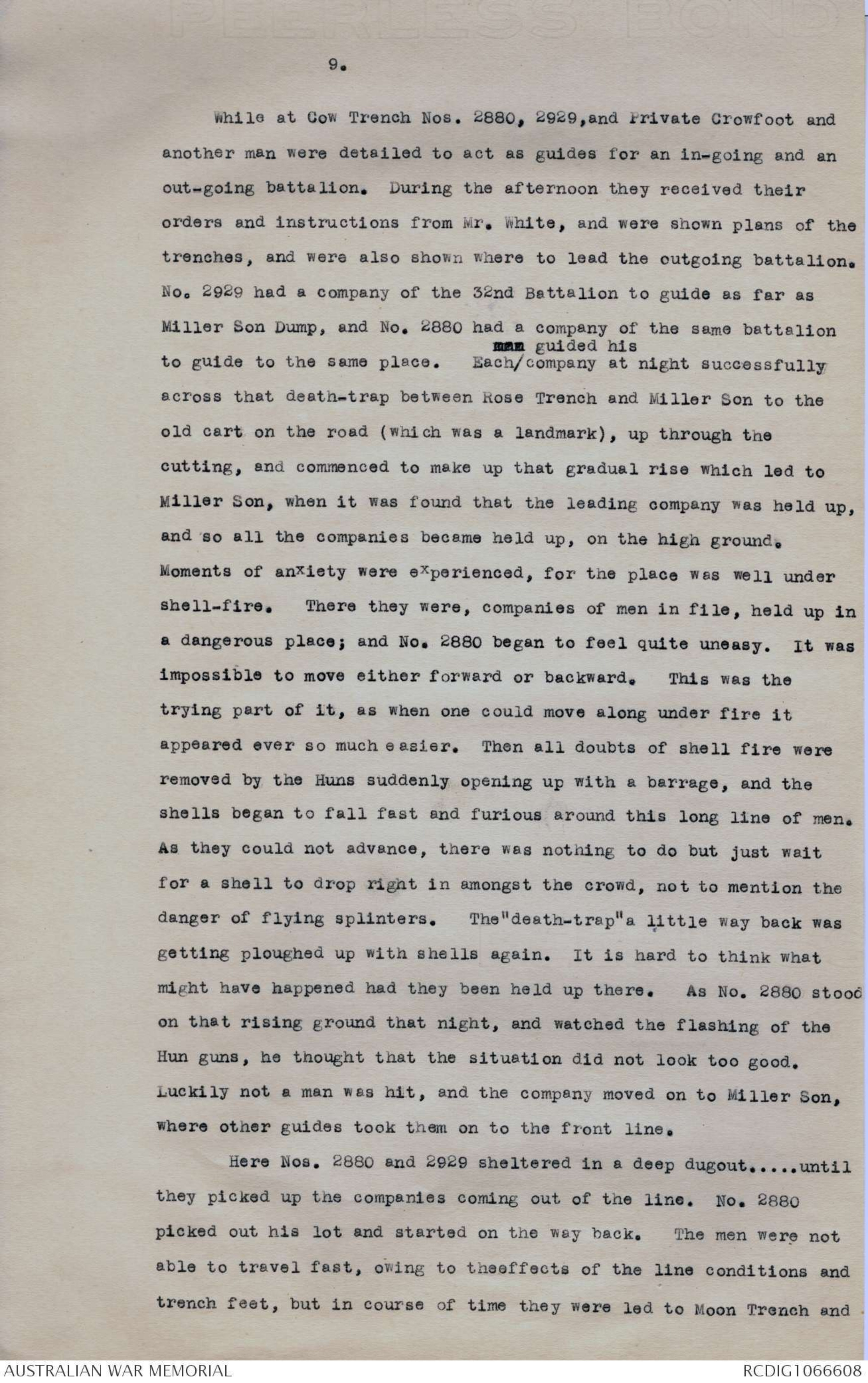
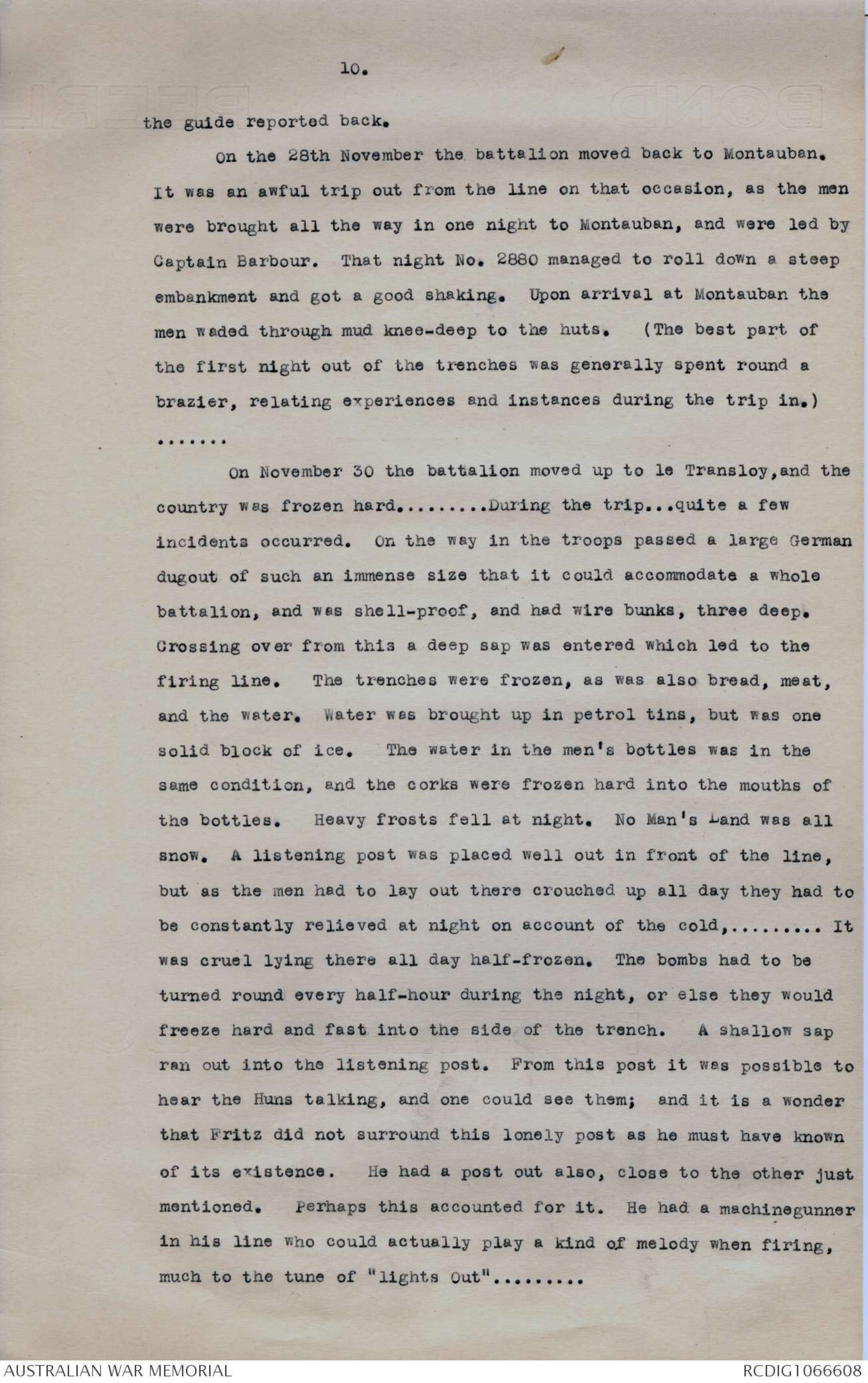

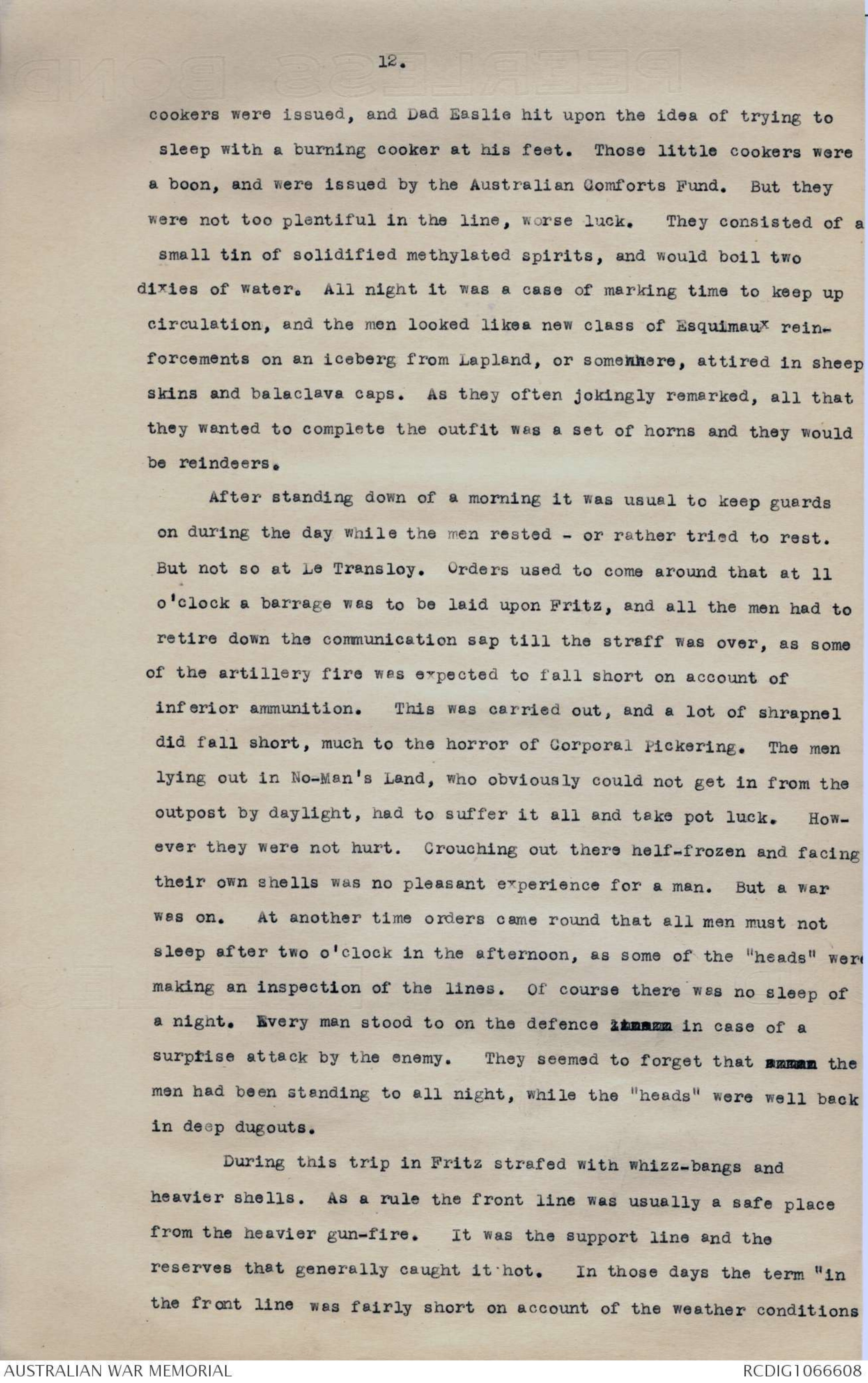
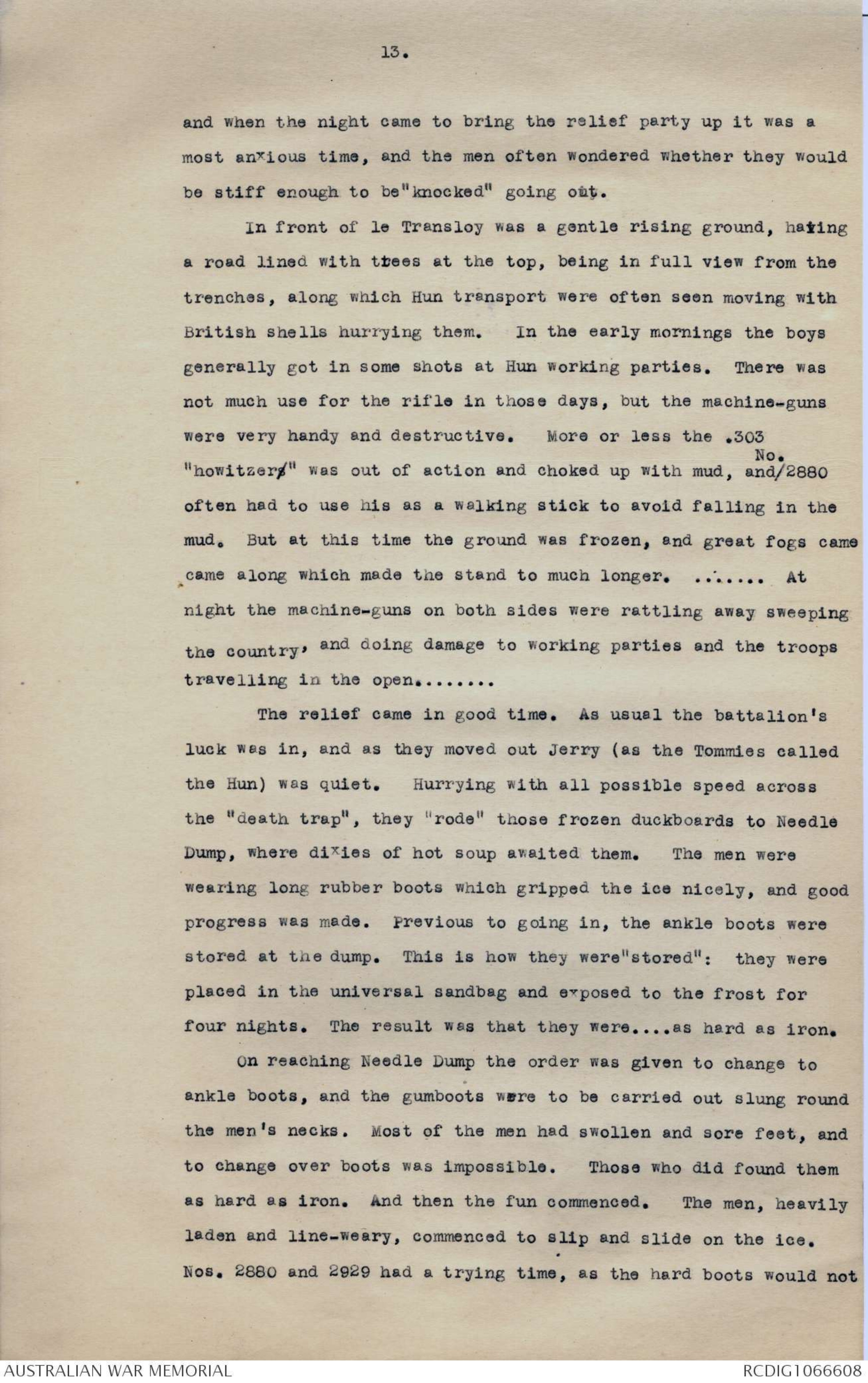
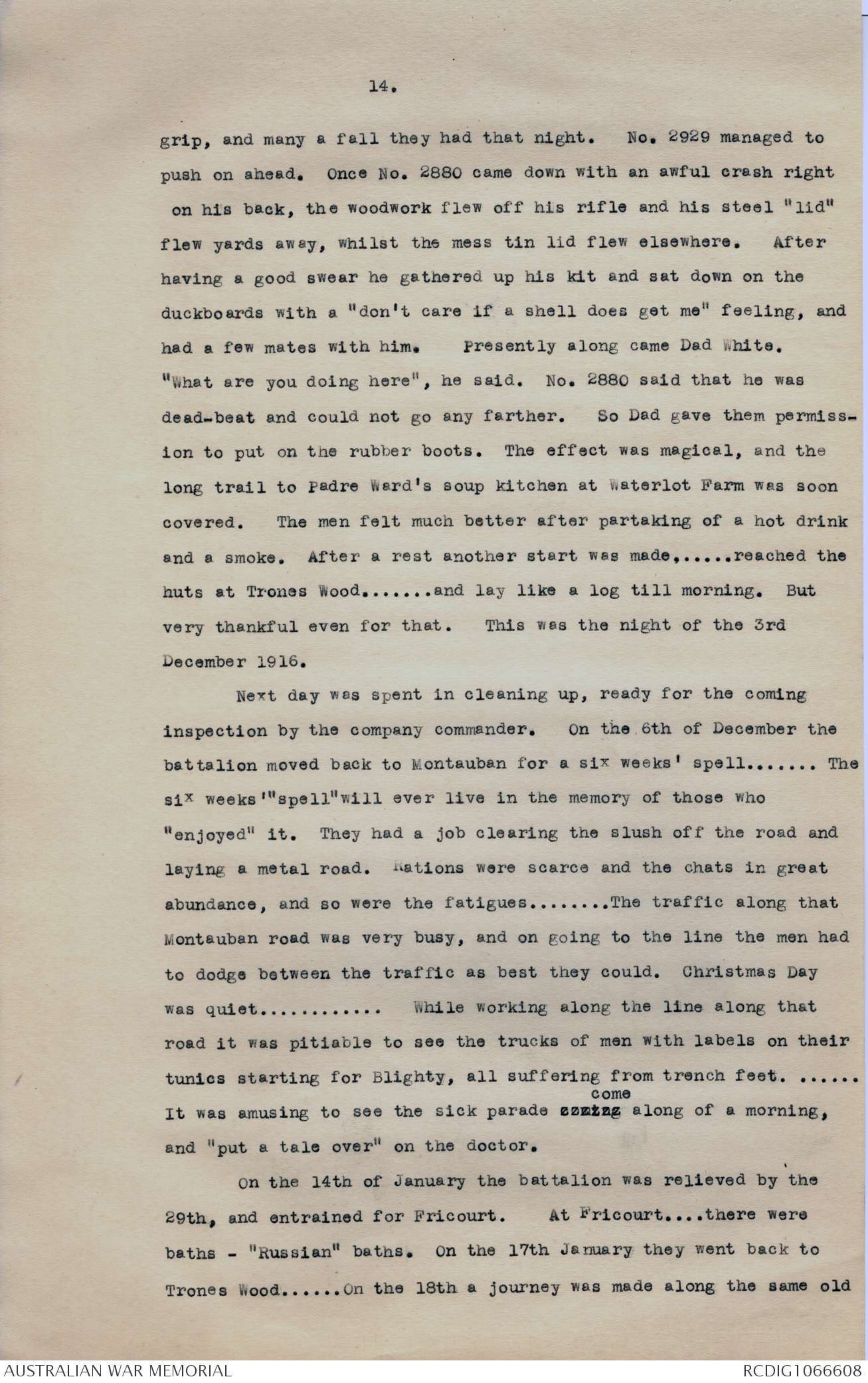
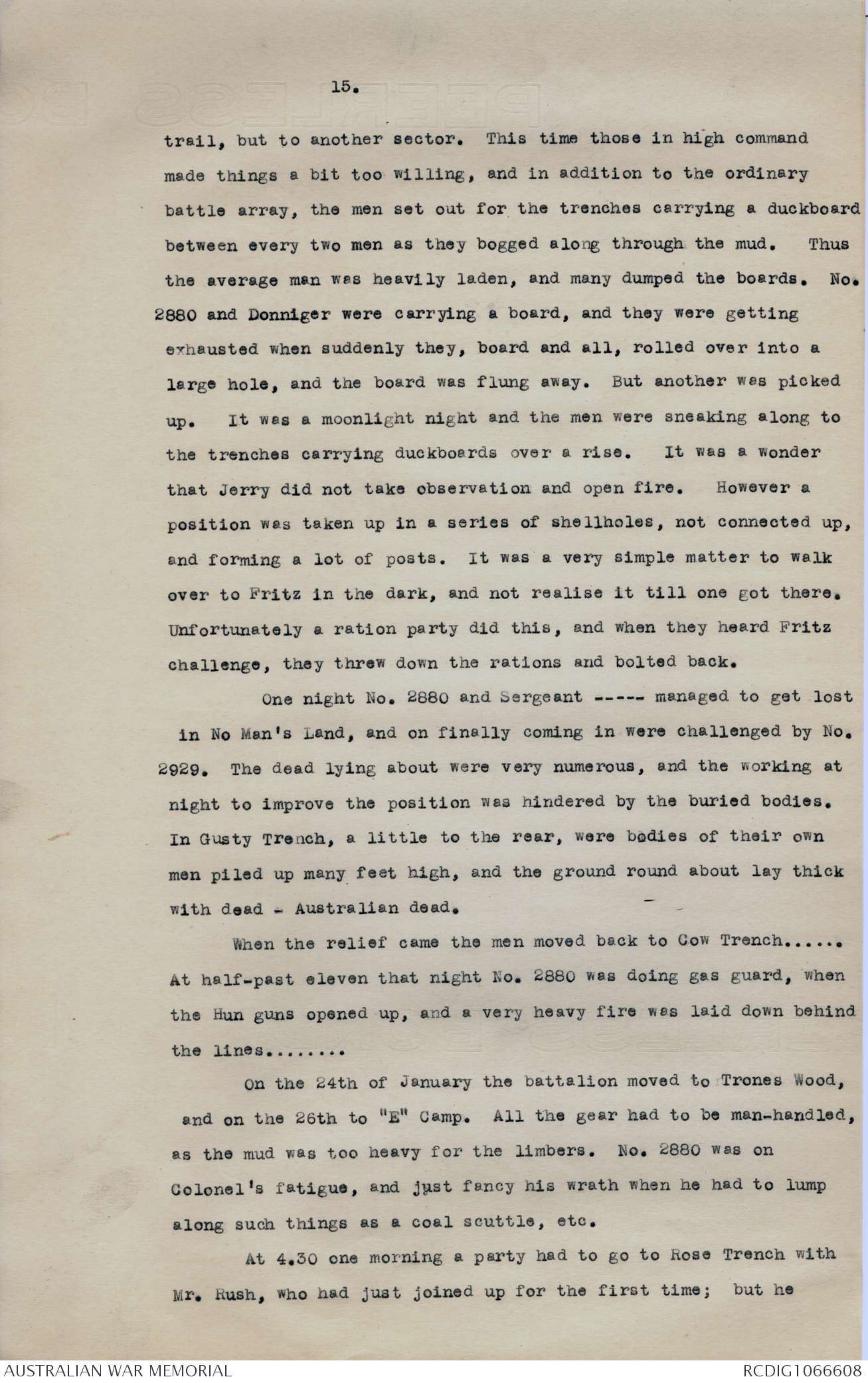
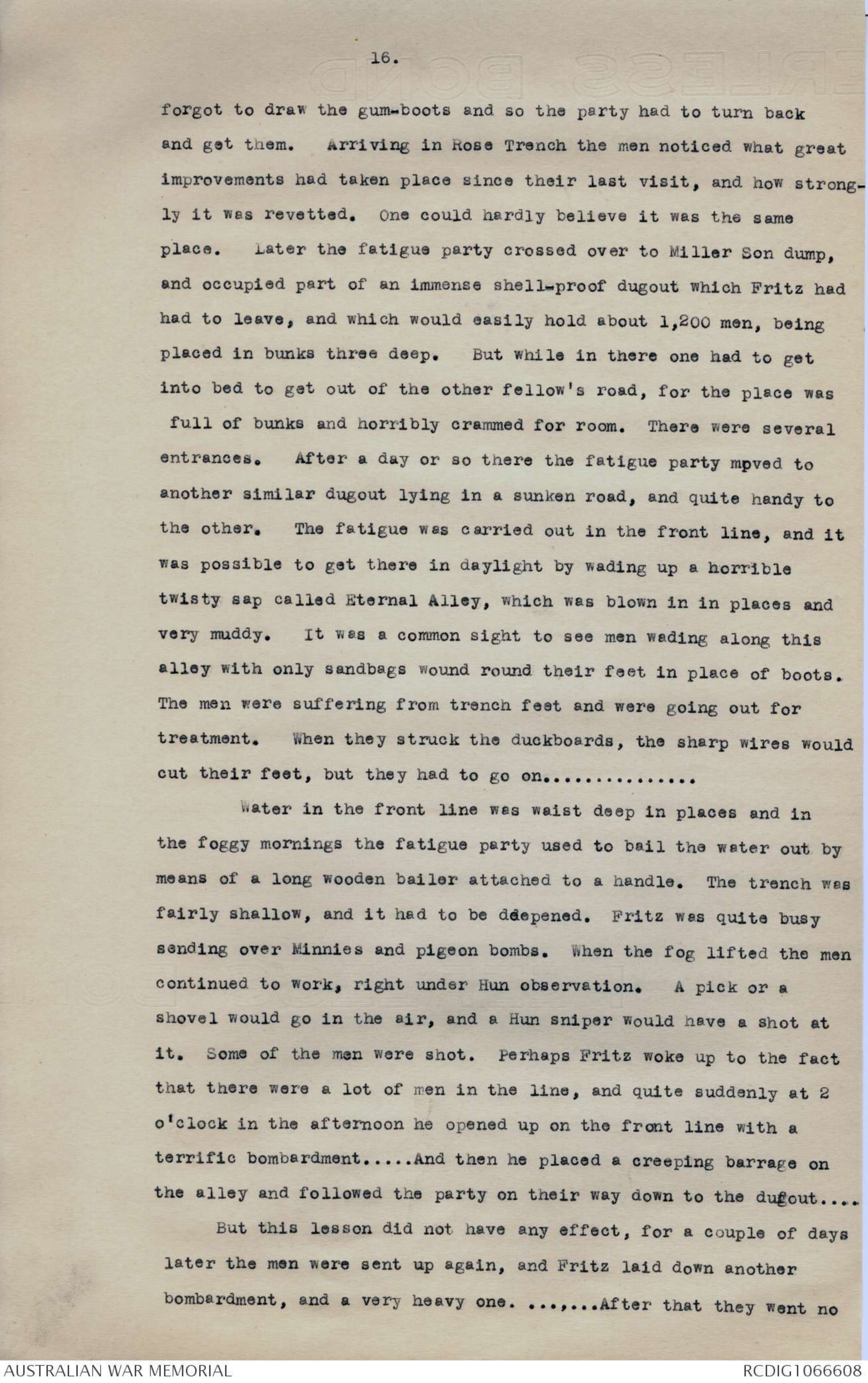
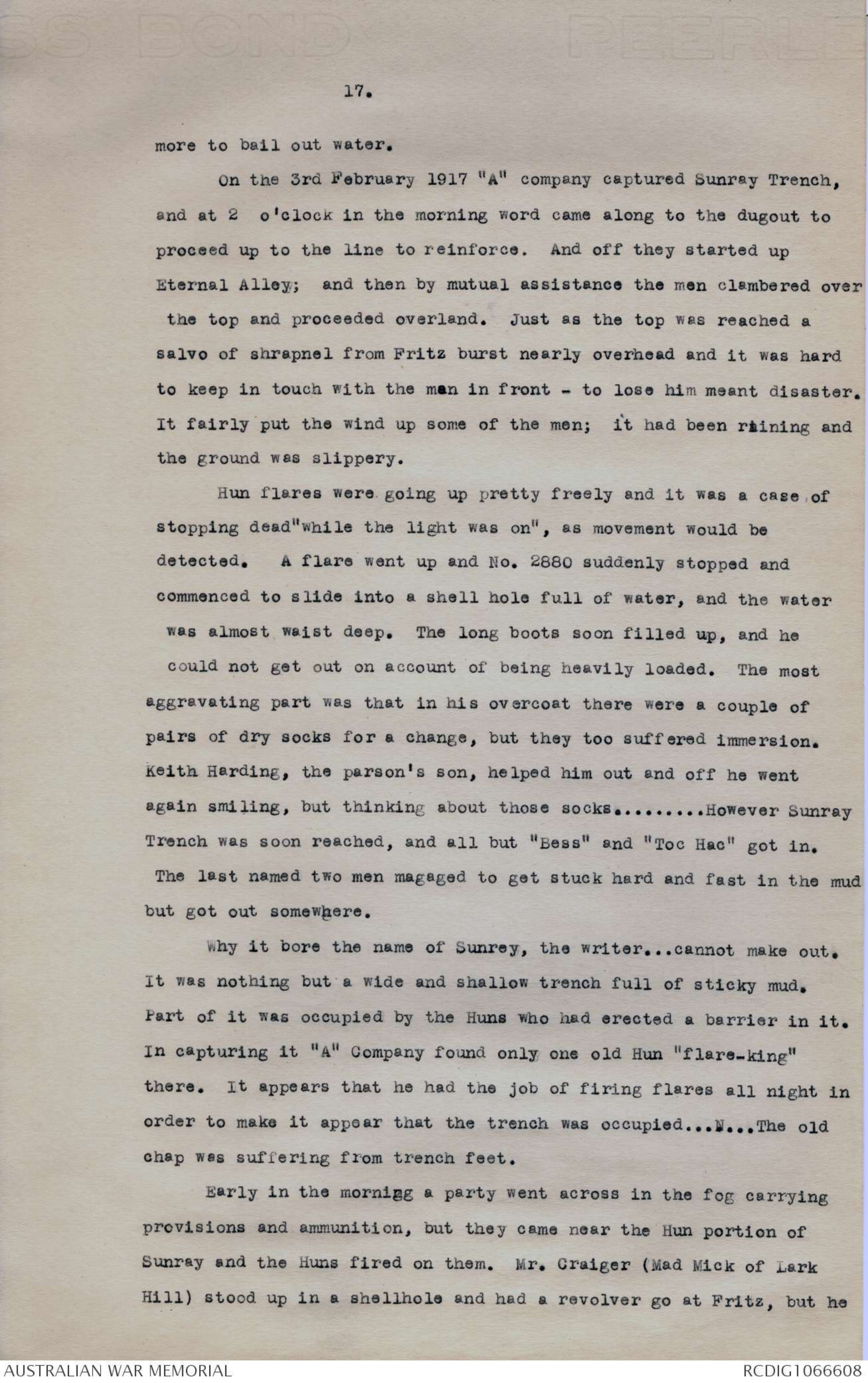
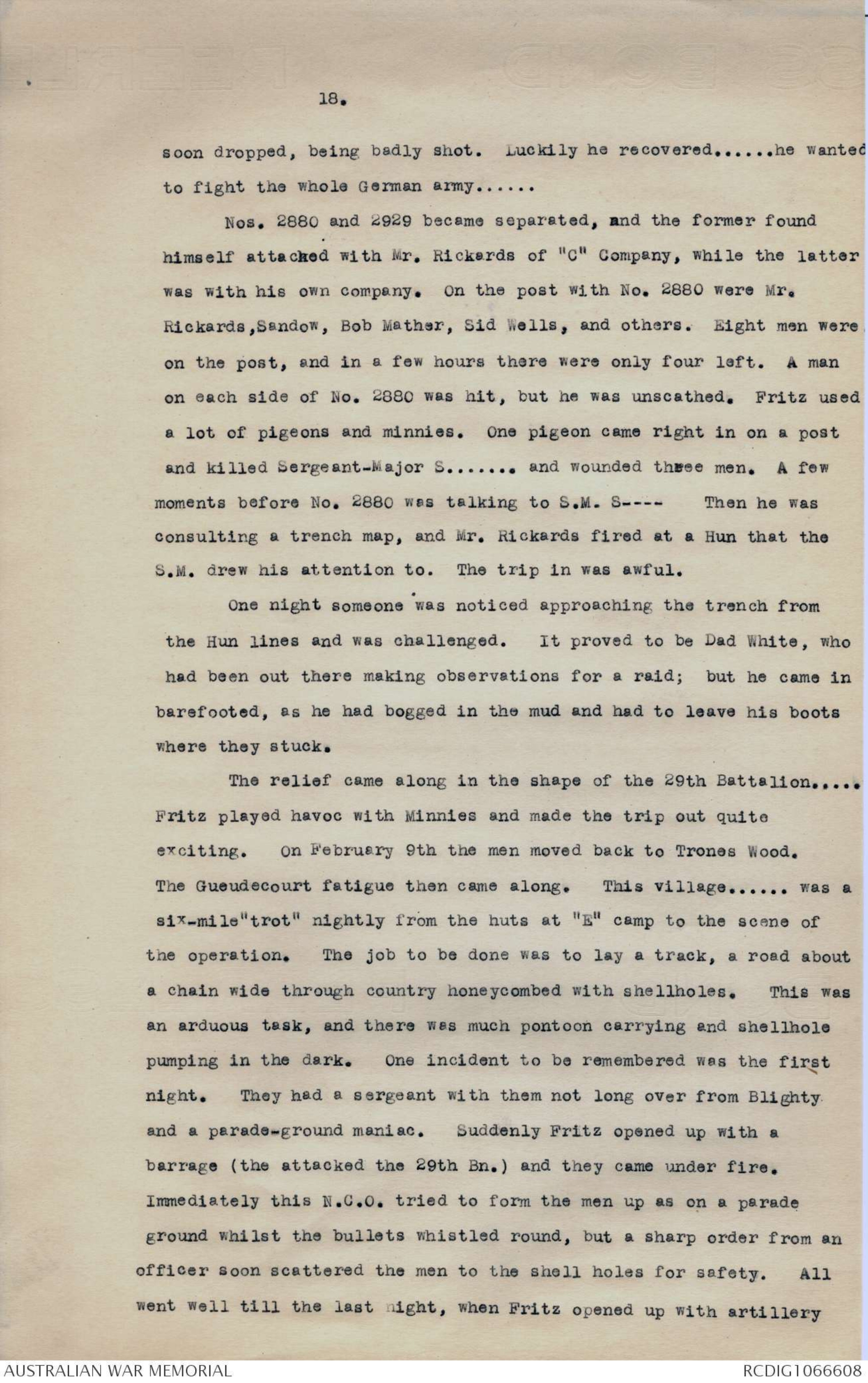
9.
While at Cow Trench Nos. 2880, 2929, and Private Crowfoot and
another man were detailed to act as guides for an in-going and an
out-going battalion. During the afternoon they received their
orders and instructions from Mr. White, and were shown plans of the
trenches, and were also shown where to lead the outgoing battalion.
No. 2929 had a company of the 32nd Battalion to guide as far as
Miller Son Dump, and No. 2880 had a company of the same battalion
to guide to the same place. Each ^man guided his company at night successfully
across that death-trap between Rose Trench and Miller Son to the
old cart on the road (which was a landmark), up through the
cutting, and commenced to make up that gradual rise which led to
Miller Son, when it was found that the leading company was held up,
and so all the companies became held up, on the high ground.
Moments of anxiety were experienced, for the place was well under
shell-fire. There they were, companies of men in file, held up in
a dangerous place; and No. 2880 began to feel quite uneasy. It was
impossible to move either forward or backward. This was the
trying part of it, as when one could move along under fire it
appeared over so much easier. Then all doubts of shell fire were
removed by the Huns suddenly opening up with a barrage, and the
shells began to fall fast and furious around this long line of men.
As they could not advance, there was nothing to do but just wait
for a shell to drop right in amongst the crowd, not to mention the
danger of flying splinters. The "death-trap" a little way back was
getting ploughed up with shells again. It is hard to think what
might have happened had they been held up there. As No. 2880 stood
on that rising ground that night, and watched the flashing of the
Hun guns, he thought that the situation did not look too good.
Luckily not a man was hit, and the company moved on to Miller Son,
where other guides took them on to the front line.
Here Nos. 2880 and 2929 sheltered in a deep dugout . . . . . until
they picked up the companies coming out of the line. No. 2880
picked out his lot and started on the way back. The men were not
able to travel fast, owing to theeffects of the line conditions and
trench feet, but in course of time they were led to Moon Trench and
10.
the guide reported back.
On the 28th November the battalion moved back to Montauban.
It was an awful trip out from the line on that occasion, as the men
were brought all the way in one night to Montauban, and were led by
Captain Barbour. That night No. 2880 managed to roll down a steep
embankment and got a good shaking. Upon arrival at Montauban the
men waded through mud knee-deep to the huts. (The best part of
the first night out of the trenches was generally spent round a
brazier, relating experiences and instances during the trip in).
On November 30 the battalion moved up to le Transloy, and the
country was frozen hard . . . . During the trip . . . quite a few
incidents occurred. On the way in the troops passed a large German
dugout of such an immense size that it could accommodate a whole
battalion, and was shell-proof, and had wire bunks, three deep.
Crossing over from this a deep sap was entered which led to the
firing line. The trenches were frozen, as was also bread, meat,
and the water. Water was brought up in petrol tins, but was one
solid block of ice. The water in the men's bottles was in the
same condition, and the corks were frozen hard into the mouths of
the bottles. Heavy frosts fell at night. No Man's Land was all
snow. A listening post was placed well out in front of the line,
but as the men had to lay out there crouched up all day they had to
be constantly relieved at night on account of the cold, . . . . . It
was cruel lying there all day half-frozen. The bombs had to be
turned round every half-hour during the night, or else they would
freeze hard and fast into the side of the trench. A shallow sap
ran out into the listening post. From this post it was possible to
hear the Huns talking, and one could see them; and it is a wonder
that Fritz did not surround this lonely post as he must have known
of its existence. He had a post out also, close to the other just
mentioned. Perhaps this accounted for it. He had a machinegunner
in his line who could actually play a kind of melody when firing,
much to the tune of "lights out" . . . .
11.
One night "Dad" White came along the trench. The Huns must have
had a very bad trench, as in the dim half-light they could be
noticed standing head and shoulders above the parapet, and they were
not far away. So "Dad" gave orders for every man to get ready to
fire two rounds when he fired his revolver. He kept the men wait-
ing for that signal, but it never came off. Perhaps he had
visiions of the shells and Minnies which Fritz would hurl back in
return, and left them well alone.
A raid came off. Sergeant Worboies (afterwards killed in
action) and Private Keene (6th Reinforcement) were sent out as a
covering party. About midnight a barrage of flying pigs and Stokes
was fired on the Hun lines. The raid came off all right, but
unfortunately Private Keene was riddled with machine-gun bullets,
and died at the dressing station . . .
The patrols got hold of the idea of dressing in white when
patrolling No Man's Land in the snow. No doubt this was copied
from Fritz. One night the patrol went out, but only clothed in
white tunics, and as they moved along in the snow a keen observer
could only discern a line of legs moving. This was not too good
for safety. The men with No. 2880 on the post were not aware of
the change of attire of the patrol, and "Ruby" Gallagher, who was
very nervy, since his mate was killed on that stretcher-bearing
party at Miller Son, became quite alarmed when he sighted the legs,
and thought he was gazing across at the spirit world. All night
long Fritz was firing flares. He supplied most of the light . . . .
The dugouts, or rather shelters, consisted of sheets of
galvanised iron which formed the roof . . . They were not sufficiently
high enough to sit up in, nor long enough to lay out in, but were
wide enough for two men to crouch in. But they were occupied by
three men,which made it awful. Truly they were a type of dugout
(as Bairnsfather puts it) in which one got out now and again for a
rest. It was not much use using them during the day, as no
blankets were carried, and the men's feet froze and caused much
pain. To keep up blood circulation it was necessary to massage
the feet rapidly, or, when it could be done, run about . . . . Tommy
12.
cookers were issued, and Dad Easlie hit upon the idea of trying to
sleep with a burning cooker at his feet. Those little cookers were
a boon, and were issued by the Australian Comforts Fund. But they
were not too plentiful in the line, worse luck. They consisted of
small tin of solidified methylated spirits, and would boil two
dixies of water. All night it was a case of marking time to keep up
circulation, and the men looked likea new class of Esquimaux reinforcements
on an iceberg from Lapland, or somewhere, attired in sheep
skins and balaclava caps. As they often jokingly remarked, all that
they wanted to complete the outfit was a set of horns and they would
be reindeers.
After standing down of a morning it was usual to keep guards
on during the day while the men rested - or rather tried to rest.
But not so at Le Transloy. Orders used to come around that at 11
o'clock a barrage was to be held upon Fritz, and all the men had to
retire down the communication sap till the straff was over, as some
of the artillery fire was expected to fall short on account of
inferior ammunition. This was carried out, and a lot of shrapnel
did fall short, much to the horror of Corporal Pickering. The men
lying out in No-Man's Land, who obviously could not get in from the
outpost by daylight, had to suffer it all and take pot luck. However
they were not hurt. Crouching out there half-frozen and facing
their own shells was no pleasant experience for a man. But a war
was on. At another time orders came round that all men must not
sleep after two o'clock in the afternoon, as some of the "heads" were
making an inspection of the lines. Of course there was no sleep of
a night. Every man stood to on the defence xxxxx in case of a
surprise attack by the enemy. They seemed to forget that xxxxx the
men had been standing all night, while the "heads" were well back
in deep dugouts.
During this trip in Fritz strafed with whizz-bangs and
heavier shells. As a rule the front line was usually a safe place
from the heavier gun-fire. It was the support line and the
reserves that generally caught it hot. In those days the term "in
the front line was fairly short on account of the weather conditions
13.
and when the night came to bring the relief party up it was a
most anxious time, and the men often wondered whether they would
be stiff enough to be "knocked" going out.
In front of Le Transloy was a gentle rising ground, having
a road lined with trees at the top, being in full view from the
trenches, along which Hun transport were often seen moving with
British shells hurrying them. In the early mornings the boys
generally got in some shots at Hun working parties. There was
not much use for the rifle in those days, but the machine-guns
were very handy and destructive. More or less the .303
"howitzers" was out of action and choked up with mud, and ∧No. 2880
often had to use his as a walking stick to avoid falling in the
mud. But at this time the ground was frozen, and great fogs came
came along which made the stand to much longer. . . . . At
night the machine-guns on both sides were rattling away sweeping
the country, and doing damage to working parties and the troops
travelling in the open. . . . .
The relief came in good time. As usual the battalion's
luck was in, and as they moved out Jerry (as the Tommies called
the Hun) was quiet. Hurrying with all possible speed across
the "death trap", they "rode" those frozen duckboards to Needle
Dump, where dixies of hot soup awaited them. The men were
wearing long rubber boots which gripped the ice nicely, and good
progress was made. Previous to going in, the ankle boots were
stored at the dump. This is how they were "stored": they were
placed in the universal sandbag and exposed to the frost for
four nights. The result was that they were . . . . as hard as iron.
On reaching Needle Dump the order was given to change to
ankle boots, and the gumboots were to be carried out slung round
the men's necks. Most of the men had swollen and sore feet, and
to change over boots was impossible. Those who did found them
as hard as iron. And then the fun commenced. The men, heavily
laden and line-weary, commenced to slip and slide on the ice.
Nos. 2880 and 2929 had a trying time, as the hard boots would not
14.
grip, and many a fall they had that night. No. 2929 managed to
push on ahead. Once No. 2880 came down with an awful crash right
on his back, the woodwork flew off his rifle and his steel "lid"
flew yards away, whilst the mess tin lid flew elsewhere. After
having a good swear he gathered up his kit and sat down on the
duckboards with a "don't care if a shell does get me" feeling, and
had a few mates with him. Presently along came Dad White.
"What are you doing here", he said. No. 2880 said that he was
dead-beat and could not go any further. So Dad gave them permission
to put on the rubber boots. The effect was magical, and the
long trail to Padre Ward's soup kitchen at Waterlot Farm was soon
covered. The men felt much better after partaking of a hot drink
and a smoke. After a rest another start was made . . . reached the
huts at Trones Wood . . . . and lay like a log till morning. But
very thankful even for that. This was the night of the 23rd
December 1916.
Next day was spent in cleaning up, ready for the coming
inspection by the company commander. On the 6th of December the
battalion moved back to Montauban for a six weeks' spell . . . . The
six weeks'"spell"will ever live in the memory of those who
"enjoyed" it. They had a job clearing the slush off the road and
laying a metal road. Rations were scarce and the chats in great
abundance, and so were the fatigues . . . . The traffic along that
Montauban road was very busy, and on going to the line the men had
to dodge between the traffic as best we could. Christmas Day
was quiet . . . . While working along the line along that
road it was pitiable to see the trucks of men with labels on their
tunics starting for Blighty, all suffering from trench feet. . . . .
It was amusing to see the sick parade coming come along of a morning,
and "put a tale over" on the doctor.
On the 14th of January the battalion was relieved by the
29th, and entrained for Fricourt. At Fricourt . . . . there were
baths - "Russian" baths. On the 17th January they went back to
Trones Wood . . . On the 18th a journey was made along the same old
15.
trail, but to another sector. This time those in high command
made things a bit too willing, and in addition to the ordinary
battle array, the men set out for the trenches carrying a duckboard
between every two men as they bogged along through the mud. Thus
the average man was heavily laden, and many dumped the boards. No.
2880 and Donniger were carrying a board, and they were getting
exhausted when suddenly they, board and all, rolled over into a
large hole, and the board was flung away. But another was picked
up. It was a moonlight night and the men were sneaking along to
the trenches carrying duckboards over a rise. It was a wonder
that Jerry did not take observation and open fire. However a
position was taken up in a series of shellholes, not connected up,
and forming a lot of posts. It was a very simple matter to walk
over to Fritz in the dark, and not realise it till one got there.
Unfortunately a ration party did this, and when they heard Fritz
challenge, they threw down the rations and bolted back.
One night No. 2880 and Sergeant ----- managed to get lost
in No Man's Land, and on finally coming in were challenged by No.
2929. The dead lying about were very numerous, and the working at
night to improve the position was hindered by the buried bodies.
In Gusty Trench, a little to the rear, were bodies of their own
men piled up many feet high, and the ground round about lay thick
with dead - Australian dead.
When the relief came the men moved back to Cow Trench . . . .
At half-past eleven that night No. 2880 was doing gas guard, when
the Hun guns opened up, and a very heavy fire was laid down behind
the lines . . . .
On the 24th of January the battalion moved to Trones Wood,
and on the 26th to "E" Camp. All the gear had to be man-handled,
as the mud was too heavy for the limbers. No. 2880 was on
Colonel's fatigue, and just fancy his wrath when he had to lump
along such things as a coal scuttle, etc.
At 4.30 on morning a party had to got to Rose Trench with
Mr. Rush, who had just joined up for the first time: but he
16.
forgot to draw the gum-boots and so the party had to turn back
and get them. Arriving in Rose Trench the men noticed what great
improvements had taken place since their last visit, and how strongly
it was revetted. One could hardly believe it was the same
place. Later the fatigue party crossed over to Miller Son dump,
and occupied part of an immense shell-proof dugout which Fritz had
had to leave, and which would easily hold about 1,200 men, being
placed in bunks three deep. But while in there one had to get
into bed to get out of the other fellow's road, for the place was
full of bunks and horribly crammed for room. There were several
entrances. After a day or so there the fatigue party moved to
another similar dugout lying in a sunken road, and quite handy to
the other. The fatigue was carried out in the front line, and it
was possible to get there in daylight by wading up a horrible
twisty sap called Eternal Alley, which was blown in in places and
very muddy. It was a common sight to see men wading along this
alley with only sandbags wound round their feet in place of boots.
The men were suffering from trench feet and were going out for
treatment. When they struck the duckboards, the sharp wires would
cut their feet, but they had to go on. . . . .
Water in the front line was waist deep in places and in
the foggy mornings the fatigue party used to bail the water out by
means of a long wood bailer attached to a handle. The trench was
fairly shallow, and it had to be deepened. Fritz was quite busy
sending over Minnies and pigeon bombs. When the fog lifted the men
continued to work, right under Hun observation. A pick or a
shovel would go in the air, and a Hun sniper would have a shot at
it. Some of the men were shot. Perhaps Fritz woke up to the fact
that there were a lot of men in the line, and quite suddenly at 2
o'clock in the afternoon he opened up on the front line with a
terrific bombardment . . . . and then he placed a creeping barrage on
the alley and followed the party on their way down to the dugout . . . .
But this lesson did not have any effect, for a couple of days
later the men were sent up again, and Fritz laid down another
bombardment, and a very heavy one. . . . . After that they went no
17.
more to bail out water.
On the 3rd February 1917 "A" company captured Sunray Trench,
and at 2 o'clock in the morning word came along to the dugout to
proceed up to the line to reinforce. And off they started up
Eternal Alley; and then by mutual assistance the men clambered over
the top and proceeded overland. Just as the top was reached a
salvo of shrapnel from Fritz burst nearly overhead and it was hard
to keep in touch with the man in front - to lose him meant disaster.
It fairly put the wind up some of the men; it had been raining and
the ground was slippery.
Hun flares were going up pretty freely and it was a case of
stopping dead"while the light was on", as movement would be
detected. A flare went up and No.2880 suddenly stopped and
commenced to slide into a shell hole full of water, and the water
was almost waist deep. The long boots soon filled up, and he
could not get out on account of being heavily loaded. The most
aggravating part was that in his overcoat there were a couple of
pairs of dry socks for a change, but they too suffered immersion.
Keith Harding, the parson's son, helped him out and off he went
gain smiling, but thinking about those socks. . . . . However Sunray
Trench was soon reached, and all but "Bess" and "Toc Hac" got in.
The last named two men magaged to get stuck hard and fast in the mud
but got out somewhere.
Why it bore the name Sunray, the writer . . . . cannot make out.
It was nothing but a wide and shallow trench full of sticky mud.
Part of it was occupied by the Huns who had erected a barrier in it.
In capturing it "A" Company found only one old Hun "flare-king"
there. It appears that he had the job of firing flares all night in
order to make it appear that the trench was occupied . . N . .The old
chap was suffering from trench feet.
Early in the morning a party went across in the fog carrying
provisions and ammunition, but they came near the Hun portion of
Sunray and the Huns fired on them. Mr. Craiger (Mad Mick of Lark
Hill) stood up in a shellhole and had a revolver go at Fritz, but he
18.
soon dropped, being badly shot. Luckily he recovered . . . . he wanted
to fight the whole German army . . . .
No. 2880 and 2929 became separated, and the former found
himself attached with Mr Rickards of "C" Company, while the latter
was with his own company. On the post with No. 2880 were Mr.
Rickards, Sandow, Bob Mather, Sid Wells, and others. Eight men were
on the post, and in a few hours there were only four left. A man
on each side of No. 2880 was hit, but he was unscathed. Fritz used
a lot of pigeons and minnies. One pigeon came right in on a post
and killed Sergeant-Major S . . . . and wounded three men. A few
moments before No. 2880 was talking to S.M. S----- Then he was
consulting a trench map, and Mr. Rickards fired at a Hun that the
S.M. drew his attention to. The trip in was awful.
One night someone was noticed approaching the trench from
the Hun lines and was challenged. It proved to be Dad White, who
had been out there making observations for a raid; but he came in
barefooted, as he had bogged in the mud and had to leave his boots
where they stuck.
The relief came along in the shape of the 29th Battalion . . . .
Fritz played havoc with Minnies and made the trip out quite
exciting. On February 9th the men moved back to Trones Wood.
The Gueudecourt fatigue then came along. This village . . . . was a
six-mile "trot" nightly from the huts at "E" camp to the scene of
the operation. The job to be done was to lay a track, a road about
a chain wide through country honeycombed with shellholes. This was
an arduous task, and there was much pontoon carrying and shellhole
pumping in the dark. One incident to be remembered was the first
night. They had a sergeant with them not long over from Blighty
and a parade-ground maniac. Suddenly Fritz opened up with a
barrage (the attacked the 29th Bn.) and they came under fire.
Immediately this N.C.O. tried to form the men up as on a parade
ground whilst the bullets whistled round, but a sharp order from an
officer soon scattered the men to the shell holes for safety. All
went well till the last night, when Fritz opened up with artillery
 Deb Parkinson
Deb ParkinsonThis transcription item is now locked to you for editing. To release the lock either Save your changes or Cancel.
This lock will be automatically released after 60 minutes of inactivity.